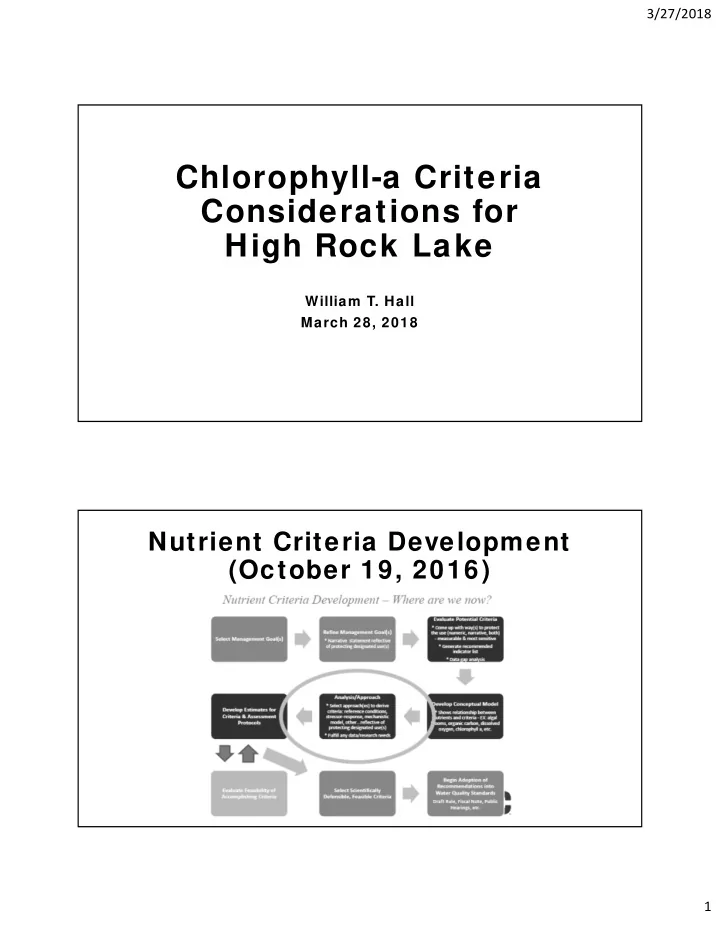

3/27/2018 Chlorophyll-a Criteria Considerations for High Rock Lake William T. Hall March 28, 2018 Nutrient Criteria Development (October 19, 2016) 1
3/27/2018 WHAT ARE CRITERIA? NATIONAL GUIDELINES PRINCIPLES • Established at Level “Necessary to Protect Uses” Ensure Use Protection with Small Probability of Considerable Over/Under-Protection Must Be Consistent With Sound Scientific Evidence - Demonstrated Dose/Response Must Account for Major Factors Influencing Pollutant Impact Confounded Studies Should Not Be Used for Criteria Derivation (or confounding factors need to be addressed) High Rock Lake Designated Uses (August 18, 2015) • Aquatic Life • Fishing • Fish consumption • Wildlife • Secondary Recreation (e.g. wading, boating) • Agricultural uses (e.g. irrigation) • Water Supply • Lower lake: Primary Recreation – full human body contact (e.g. swimming, water skiing) 2
3/27/2018 High Rock Lake Designated Uses May 6, 2015 • Maintenance of biological integrity Biological integrity means the ability of an aquatic ecosystem to support and maintain a balanced and indigenous community of organisms having species composition, diversity, population densities and functional organization similar to that of reference conditions. Conceptual Model (Feb. 17, 2016) 3
3/27/2018 LIGHT RESIDENCE TEMPERATURE PHOSPHORUS NITROGEN ‐ Season TIME ‐ Season ‐ External Load ‐ External Load ‐ Color ‐ Inflow ‐ Stratification ‐ Internal Recycle ‐ Internal Recycle ‐ Volume ‐ Turbidity ‐ Stratification RESPIRATION SUSPENDED SEDIMENTS ALKALINITY PRIMARY PRODUCTIVITY DEPTH ALGAL CHLOROPHYLL ‐ a BIOVOLUME ASSEMBLAGE DISSOLVED OXYGEN WATER CLARITY pH TASTE NITROGEN ‐ Hypolimnetic ALGAL ORGANIC ‐ Algal Turbidity ‐ Diurnal Variation AND SPECIES ‐ Diurnal Variation TOXINS CARBON ‐ Color ‐ High/Low pH ODOR (NO 3 , NH 4 ) ‐ Low DO AQUATIC LIFE WATER SUPPLY With Human Health Considerations RECREATION (Point of Use) Biomass, Assemblage: With Human Health Considerations With Human Health Considerations ‐ Macroinvertebrates ‐ Primary ‐ Drinking Water ‐ Zooplankton ‐ Secondary ‐ Agricultural ‐ Fish BLACK BOX HIGH ROCK LAKE, NORTH CAROLINA Causal indicator NUTRIENT ‐ RELATED CONCEPTUAL MODEL Model Description and Legend YELLOW BOX & ARROWS Respiration & related causal indicators The Scientific Advisory Council (SAC) for North Carolina’s Nutrient PINK BOX & ARROWS Criteria Development Plan has developed a conceptual model to GREEN BOX & ARROWS Chlorophyll a visually depict ecological linkages of nutrient ‐ related variables Primary productivity & related response indicators (documented as “indicators”) in High Rock Lake. & related causal indicators BLUE BOX & ARROWS Components of productivity Algal biovolume Causal indicators include nitrogen and phosphorus inputs and (measured in different ways) : & related response indicators environmental factors, such as light penetration and in ‐ lake water ‐ Chlorophyll a residence time. The model includes multiple levels of response RED BOX & ARROWS ‐ Biovolume indicators which may influence one another in a step ‐ wise manner. Algal assemblage ‐ Algal Assemblage For example, variations in causal indicator nutrient levels will impact & related response indicators response indicators that are primary productivity components (i.e. chlorophyll a , biovolume and algal assemblage), which in turn lead to PURPLE BOX changes in other response indicators, such as dissolved oxygen and/or Response indicator algal toxin concentrations. These relationships provide a scientific basis for discussions and OVAL development of criteria to support the designated uses of High Rock (COLOR VARIES BY USE) Lake, including Aquatic Life, Drinking Water Supply and Recreation. Designated uses & related indicators All causal and response indicators will be considered toward the goal ‐ Aquatic Life of developing the most effective criteria for maintaining an ecological condition within the lake that supports the uses. ‐ Recreation ‐ Water Supply 4
3/27/2018 Algal Composition (August 18, 2015) 5
3/27/2018 Chlorophyll-a Proposals 1. Clifton 2. Lauren • Risk Level Evaluation Category Basis Conc. 9.3% blue greens Low Low DW concerns 16.5 µ g/L < 10 µ g/L microcystin 46.3% blue greens Medium DW use impairments 30.6 µ g/L 10 ‐ 20 µ g/L microcystin 61.5% blue greens High DW use severely impaired 47.5 µ g/L >20 µ g/L microcystin 6
3/27/2018 What Do We Know ? • HRL Chl-a Concentrations exceed 50 µg/L in mid-lake and arms, close to 40 µg/L near dam • Aquatic Life Use Impairments have not been identified • Recreational Use Impairments have not been identified • Potable Water Use Impairments below the lake have not been identified • Although blue green algae proliferate in the summer months, elevated levels of cyanotoxins have not been observed Conclusion The available data for High Rock Lake are insufficient to develop numeric nutrient criteria for chlorophyll-a. 7
3/27/2018 What Do We Do Now ? • Retain existing 40 µg/L standard (Do Nothing Alternative). • Clarify that existing standard is an average. (growing season or annual) (arithmetic or geometric) • Provide Off-Ramp where there is no evidence of use impairment for lakes that already exceed 40 µg/L. • Use anti-degradation requirements to prevent deteriorating conditions. Other Considerations • If possible, establish Aquatic Life WQC for “Balanced Indigenous Population of Organisms” Need to define for various types of lakes Determine defensible relationship between Chl-a and BIP • If possible, establish WQC for recreation based on water clarity Determine defensible relationship between Chl-a and clarity (easy) • For non-stratified lakes, relate primary productivity to DO (may be lake- specific) • Establish WQC for cyanotoxins For lakes that support toxin forming blue-greens, that produce toxins in excess of WQC, determine defensible relationship between Chl-a and toxin threshold. 8
Recommend
More recommend